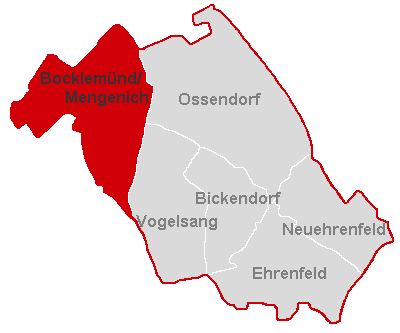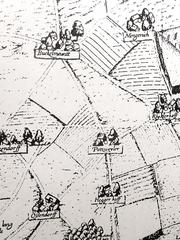
Bocklemünd/Mengenich Visiting Hours, Tickets, and Historical Sites Guide
Date: 14/06/2025
Introduction to Bocklemünd/Mengenich Cologne Historical Site
Bocklemünd/Mengenich, situated on the northwestern edge of Cologne, Germany, is a district where deep-rooted history meets modern cultural innovation. With settlement traces dating back over 6,000 years, including evidence of the Linear Pottery culture and Roman estates, the area is a treasure trove for archaeology and history enthusiasts (Stadt Köln). Medieval manor farms, ecclesiastical legacies, and later urban integration offer a vivid narrative of Cologne’s evolution. Today, Bocklemünd/Mengenich stands as a dynamic community, home to landmarks like Fort IV—a 19th-century Prussian fortification—media and biotech hubs, and vibrant local life (koeln.mitvergnuegen.com; koeln.de). This guide provides comprehensive details on visiting hours, tickets, accessibility, as well as cultural events, nearby attractions, and tips for making the most of your visit.
Table of Contents
- Introduction
- Early Origins and Archaeological Heritage
- Medieval Development and Ecclesiastical Ties
- Urban Integration and Modern Development
- 20th Century Transformations
- Cultural and Architectural Landmarks
- Modern Identity: Media, Science, and Community
- Visitor Information: Hours, Tickets, Accessibility
- Tips for Your Visit
- Frequently Asked Questions (FAQs)
- Conclusion
Early Origins and Archaeological Heritage
Bocklemünd/Mengenich’s origins are among the oldest in the Cologne region. Archaeological finds reveal a Bandkeramik (Linear Pottery) settlement in Mengenich dating back to around 4200 BCE, with continuous habitation through the Bell Beaker, Bronze, and Iron Ages (Stadt Köln). The district’s name, from the Latinized Celtic “Magniniacum,” indicates a Roman estate once existed here. The Bocklemünd tombstone dedicated to the Roman goddess Virtus, dating to the 3rd century CE, further underscores the area’s rich Roman heritage (bocklemuend-mengenich.de).
Medieval Development and Ecclesiastical Ties
The first documented mention of Bocklemünd dates to 941 CE, when Archbishop Wigfried granted the village to the nuns of St. Cecilia’s convent. The district’s name reflects the hilly terrain (“Buckel” meaning hill). Through the Middle Ages, agriculture dominated, and several manor farms from this period survive as protected monuments (koeln.mitvergnuegen.com).
Urban Integration and Modern Development
Incorporated into Cologne in 1888, Bocklemünd and Mengenich transitioned from small villages to urban neighborhoods. Transport improvements, including the 1899 railway station and the 1917 extension of Cologne’s tramway, fostered stronger connections to the city (bocklemuend-mengenich.de).
20th Century Transformations
World War II inflicted significant damage, notably destroying the St. Johann church in 1943. Postwar years saw rapid change, especially with the 1960s “Trabantenstadt” housing project, which added thousands of new residential units (ferienwohnung-koeln.com). The villages formally merged in 1950, and by the 21st century, the population approached 11,000 (Stadt Köln).
Cultural and Architectural Landmarks
Historic Farmsteads
Discover centuries-old manor farms along Militärringstraße, offering a glimpse into the district’s agricultural heritage (koeln.mitvergnuegen.com).
Fort IV
Constructed in 1874, Fort IV is one of Cologne’s largest 19th-century fortifications. Guided weekend tours are available, providing fascinating insights into military history and panoramic city views (koeln.mitvergnuegen.com).
Zwischenwerk IIIb
A remnant of Prussian military architecture at Buschweg and Militärringstraße, now used for private events.
Jewish Cemetery
Near Ehrenfeld, the Jewish Cemetery is notable for its expansive grounds, impressive mourning hall, and artistically significant graves (koeln.mitvergnuegen.com).
Gut Vogelsang
This historic estate now houses the Max Planck Institute for Plant Breeding Research (kuladig.de).
Modern Identity: Media, Science, and Community
Bocklemünd/Mengenich is home to Westdeutscher Rundfunk (WDR) television studios, where the iconic series “Lindenstraße” was filmed (kuladig.de). The district also hosts BioCampus Cologne, a major biotechnology park, and is characterized by a vibrant, multicultural community.
Visitor Information: Hours, Tickets, Accessibility
- Visiting Hours: Most outdoor sites are accessible during daylight hours. Fort IV tours are typically held on weekends; verify times on official websites.
- Tickets: Outdoor sites and farmsteads are free to access. Guided tours of Fort IV and other sites may require a ticket and advance booking.
- Accessibility: Bocklemünd/Mengenich is reachable by Cologne’s public transport (tram line 3, regional trains, and buses). Some historic sites have limited accessibility; check with tour providers.
- Guided Tours: Themed tours are available by advance reservation, focusing on historical, military, and scientific themes.
Tips for Your Visit
- Bring a camera to capture distinctive contrasts between historic farmsteads, modern housing, and media studios.
- Comfortable footwear is recommended, as some sites involve walking on uneven ground.
- Explore local events and markets organized by the Bürgerverein for an authentic community experience.
Frequently Asked Questions (FAQs)
Q: What are the visiting hours for Bocklemünd/Mengenich landmarks?
A: Outdoor landmarks are accessible during daylight; Fort IV tours usually occur on weekends.
Q: Are tickets required for historical sites?
A: Most sites are free. Guided tours, such as at Fort IV, require tickets—book in advance.
Q: How do I get there?
A: Bocklemünd/Mengenich is accessible via Cologne’s tram line 3, regional trains, and buses.
Q: Are sites accessible for visitors with limited mobility?
A: Some are; confirm with tour organizers for specific accessibility information.
Q: Are guided tours available?
A: Yes, especially for Fort IV and historical walks. Booking in advance is advised.
Fort IV Cologne: A Historical Monument and Visitor Guide
Overview
Fort IV, set within Bocklemünd/Mengenich, is a well-preserved example of Cologne’s Prussian fortifications. Built in the 1870s, it now serves as a monument to military history and urban development.
- Opening Hours: Grounds open daily from 8:00 AM to 6:00 PM (hours may vary seasonally).
- Admission: Free to the grounds; guided tours require tickets, available online (Cologne Historical Sites Official Website).
- Access: Tram line 3 terminates at Bocklemünd, a short walk from Fort IV; parking and bike paths are available.
Nearby Attractions: Vogelwäldchen (woodland park), Christi Geburt Church, and Görlinger Zentrum (community hub).
Visitor Tips:
- Wear comfortable shoes for exploring the grounds and green belts.
- Photography is encouraged; drone use by permission.
- For events and tour dates, check the official social media channels and Sozialraumkoordination Bocklemünd/Mengenich portal.
Accessibility: Some areas may be uneven; contact the visitor center for advice.
Bocklemünd/Mengenich: District Overview and Experiences
Historical Roots and Urban Identity
Bocklemünd/Mengenich’s dual heritage blends agrarian roots with 20th-century urbanization. The district’s name reflects both topography and ancient lineage, with archaeological and Roman influences evident in local place names (koeln.de).
Media, Innovation, and Community
Known for the WDR studios and the nickname “Hollymünd,” the district is a creative production center. BioCampus Cologne is a hub for research and biotech startups, contributing to the local economy and innovation scene.
Community Life
Enjoy weekly markets, multicultural festivals, and second-hand shops supporting sustainable practices. The Görlinger Zentrum area is a focal point for both residents and visitors (th-koeln.de).
Getting There
Tram lines 3 and 4, and several bus routes provide direct connections to Cologne city center (shirshendusengupta.com).
Parks, Green Spaces, and Recreation
- Landschaftspark Belvedere: Walking and cycling paths, city views, open lawns. Open daily, dawn to dusk.
- Bürgerpark Bocklemünd: Playgrounds, sports facilities, and event spaces. Open daily, 7:00 AM–9:00 PM.
- Access to Green Belt: Connects to hiking and cycling trails throughout Cologne (Germany Travel Blog).
Notable Nearby Attractions
- Cologne Cathedral (Kölner Dom): UNESCO World Heritage Site, 7 km away (PlanetWare).
- Old Town (Altstadt), Museum Ludwig, Wallraf-Richartz Museum: Easily reachable by public transport.
- Ehrenfeld: Renowned for street art and alternative culture (My Germany Vacation).
Visitor Tips
- Public Transport: Use tram line 3 or buses. Travel time to city center is approximately 20–25 minutes.
- Cycling: Extensive bike paths connect the district to the Green Belt and nearby neighborhoods.
- Best Time to Visit: Spring–early autumn for festivals and pleasant weather.
- Accessibility: Most public areas and transport are accessible (Cologne Tourism Accessibility).
- Safety: Standard urban precautions apply.
FAQ
Q: When is Bocklemünd Cemetery open?
A: April–September: 8:00 AM–7:00 PM; October–March: 8:00 AM–5:00 PM.
Q: How can I join a tour of Fort IV?
A: Tours are held during heritage events; consult local listings and the Cologne Historical Sites.
Q: Are markets and community events open to visitors?
A: Yes, visitors are welcome at weekly markets and most local events.
Conclusion
Bocklemünd/Mengenich is a district where Cologne’s layered history is matched by cultural vibrancy and ongoing innovation. Explore ancient sites, manor farms, and military monuments, or experience the energy of contemporary media and biotech hubs. With excellent public transport, thriving community life, and a wealth of green spaces, Bocklemünd/Mengenich offers every visitor an authentic slice of Cologne’s past and present.
For current events, guided tour details, and the latest updates, visit the official Cologne city portal and the Cologne Historical Sites website. Download the Audiala app for audio tours and follow us on social media for up-to-date tips and event news.
References and Further Reading
- Bocklemünd/Mengenich: A Visitor’s Guide to Cologne’s Historic District and Cultural Landmarks, 2024 (Stadt Köln)
- Bocklemünd/Mengenich Historical Information, 2024 (bocklemuend-mengenich.de)
- Bocklemünd/Mengenich Cultural and Economic Significance, 2024 (koeln.de)
- Fort IV Cologne: Visiting Hours, Tickets, History, and Visitor Guide, 2024 (koeln-tourismus.de)
- Exploring Bocklemünd/Mengenich: Visiting Hours, Tickets, and Top Historical Sites, 2024 (Cologne Tourism)






































































